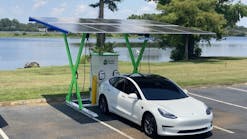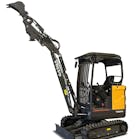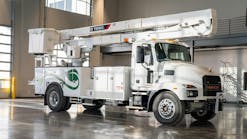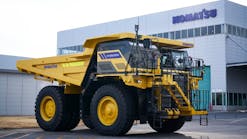The most precise definition we encountered is that from Caterpillar: A hybrid is “a machine equipped with a device to collect, store and release energy during operation.”
By that definition, a number of machines and trucks with innovative energy-use technology would qualify as hybrids. A few machines, however, with technology just as innovative, would be ruled out on technicalities—the Cat D7E crawler dozer, for instance, because its distinctive electrical/mechanical power train neither collects, stores nor releases stored energy, and several wheel loaders—the Cat 966K XE, Deere 644K Hybrid, and Deere 944K—which collect and use energy that otherwise would be wasted, but do not store it.
We’ve taken the liberty, then, of expanding “hybrid” to mean any machine employing energy-use technology usually not seen in that particular equipment type or size, or, in other words, employing energy-use technology that stands out from conventional designs.
Fundamental principles of hybrids
While considering definitions, it might be helpful to mention two more terms frequently encountered in hybrid technology—regenerative braking and motor/generator.
Regenerative braking, a process that lies at the heart of many hybrid systems, is broadly defined as the process of decelerating or stopping a moving mass—be it a speeding wheel loader, an excavator’s rotating upper structure, or the descending boom of a mining shovel—by converting its kinetic energy into another form of energy that can be stored or used immediately to do work. The process needs further explanation, but keep in mind that it works, fundamentally, by using machine inertia to momentarily force electric motors to function as generators and hydraulic motors to function as pumps.
The motor/generator, a component in electrically based hybrid systems, can function both as an electric motor and as a generator. It is integrated with the engine in such a manner that, when serving as a motor, it can add rotational force to that of the engine or can assist in driving hydraulic pumps, thus easing the burden on the engine and saving fuel. As a generator, the motor/generator supplies current to other electric motors in the system or charges electrical storage devices, such as a battery or capacitor, a device that rapidly stores and releases large amounts of electrical energy.
Basic hybrid systems
The Komatsu HB215LC-1 hydraulic excavator illustrates an electrically based hybrid system that employs regenerative braking to capture and store the kinetic energy of a decelerating upper structure. Unlike conventional excavators that use a hydraulic swing motor, the Komatsu hybrid uses an electric swing motor. When the swing lever is released and the swing motor is no longer powered, the motor is now driven by machine inertia, causing it to work as a generator and to bring the upper structure to a stop.
(The regenerative-braking process in electrically based hybrid systems has a retarding effect on electric motors—functioning as generators—when the generated power encounters a load in the electrical system. The process also is called “dynamic braking” and is further defined as “rheostatic” if generated power is simply dissipated as heat, or “regenerative” if the power is used for useful work.)
The Komatsu system is regenerative, because the current produced is directed to a capacitor. Power stored in the capacitor can then be used either to power the swing motor during swing acceleration, or to drive the system’s motor/generator as a motor to add up to 60 horsepower to the engine’s force for driving hydraulic pumps. When working as a generator, the motor/generator sends power to the capacitor for storage via an inverter.
The Cat 336E H hybrid excavator, on the other hand, uses regenerative braking to store kinetic energy hydraulically. Like all excavators using a hydraulic swing motor, the 336E H begins to decelerate the upper structure when the swing lever is released and the swing motor is no longer driven by the system’s pump. At this point, the machine’s swing inertia becomes the force driving the motor, causing it to now act as a pump.
In conventional excavators, this oil flow from the motor (now acting as a pump) is blocked at the system’s neutralized pump, creating resistance in the circuit that essentially locks up the swing motor. This process, “hydrostatic braking,” converts kinetic energy to heat. The Cat 336E H, however, directs this oil flow through its Swing Energy Recovery Valve and into nitrogen-charged accumulators. Kinetic energy from swing inertia is thus stored for reuse as the oil compresses the gas in the accumulators. We assume that the resistance to oil flow inherent in the process stops the swing motor.
Yet another system for capitalizing on an excavator’s swing-deceleration energy is that in Hitachi’s New Generation ZH200 excavator (not available in North America), which uses two swing motors (one electric, one hydraulic), a capacitor, and a motor/generator.
Schematics of the Hitachi system indicate that during swing deceleration, the electric swing motor serves as a generator to charge the capacitor, which then powers the electric swing motor during swing acceleration to assist the hydraulic motor. The motor/generator, says Hitachi, is “connected to the hydraulic pumps [and] adjusts the amount of electrical energy stored in the capacitor,” indicating, it seems, that it can both assist the engine and charge the capacitor.
The hybrid system in Kobelco’s SK-80H-2 excavator (developed for the Japanese market in 2010) is distinctive in that it combines both electric and hydraulic aspects. The system uses an engine-driven generator to charge both a capacitor and a nickel-metal hydride battery via a converter. Stored power is directed through inverters to four electric motors. Three of the motors drive a connected hydraulic pump, thus creating oil flow to the boom, arm/bucket, and travel circuits. The fourth electric motor powers the swing function directly, and, when acting as a generator during swing deceleration, it charges the capacitor and battery.
In addition, the Kobelco system places the electric-motor/hydraulic-pump combination that powers the boom on a separate circuit, so when the boom is lowered, kinetic energy in the descending boom forces oil exiting the boom circuit to drive the circuit’s pump as a motor. The pump-turned-motor subsequently drives its connected electric motor as a generator, sending current, along with that from the swing motor, to the battery and capacitor for storage. In some instances, says Kobelco, the entire machine can be powered electrically—with the engine off—resulting in significant fuel savings and whisper-quite operation in sensitive environments.
Electrical/mechanical designs
LeTourneau wheel loaders have used a basic diesel/electric drive train for decades, with an engine-driven generator powering four electric motors at the wheels. When stopping these machines, some with operating weights approaching 600,000 pounds, conventional friction brakes converted the loader’s kinetic energy to heat. Generation 2 models, however, with their Switched Reluctance Hybrid Technology Propulsion System, come to a stop via regenerative braking, converting huge amounts of kinetic energy into electrical energy.
The regenerative-braking system, says the manufacturer, brings the loader to a stop without using its conventional friction brakes, saving mechanical wear. In addition, although details are unavailable for explaining precisely how captured energy is employed to assist machine operation, the hybrid drive system is credited with promoting reductions in fuel consumption of up to 45 percent, compared with predecessor models.
Although LeTourneau wheel loaders have attained hybrid status with their Generation 2 design, their basic diesel/electric drive system is not new. But diesel/electric drive in a smaller wheeler loader (Deere’s 944K) and the integration of electrical- and mechanical-drive systems in the Cat D7E dozer and Deere 644K Hybrid wheel loader (Deere is curently taking orders) are designs far from conventional.
Tilt the cab of the Cat D7E and you’ll notice that un-crawler-like components—such as an engine-driven generator, power inverter, and propulsion module— have replaced the conventional torque converter and power-shift transmission. The generator produces 480 volts of AC power that the system converts to both DC current and “frequency-controlled” AC current, the latter powering two large electric motors geared together in the propulsion module, which drives a conventional Cat differential steering system and planetary finals. DC current at 340 volts powers the machine’s water pump and air-conditioning system.
Deere’s 944K is similar in design to that of LeTourneau loaders, but uses two engine-driven motor/generators to power its four electric drive motors. The 944K recovers the kinetic energy of machine deceleration via the drive motors working as generators, then applies the captured energy, says Deere, “back to the engine crankshaft to reduce engine load and fuel consumption, as well as to deliver power to other vehicle systems.”
The 644K Hybrid reflects a different approach, using an engine-driven motor/generator to power a single electric motor via a water-cooled inverter. The motor drives a simplified power-shift transmission (no torque converter and no reverse gearing, because the motor reverses) and conventional axles. The machine employs regenerative braking when, during deceleration, the mechanical drive train turns the electric motor as a generator, capturing energy that the motor/generator can use “to drive hydraulics and save fuel,” says Deere. The system also incorporates a water-cooled brake resistor to consume excess recycled energy.
Eaton’s electric hybrid system—available for commercial trucks—inserts a motor/generator between the clutch and the transmission. Regenerative braking occurs during deceleration, when the truck’s inertia works through a conventional drive train to force the motor/generator to work as generator, storing power in lithium-ion batteries. Stored power, regulated by an electronic control system, is then used to drive the motor/generator as a motor to either blend its force with engine torque, or to move the truck (launching it from a stop) independent of the engine.
Hydraulic hybrids
Eaton’s Hydraulic Launch Assist hydraulic hybrid system combines the truck’s conventional power train with a hydraulic pump/motor that is connected to the driveline via a transfer case. During deceleration, the drive train converts the vehicle’s kinetic energy to hydraulic energy as it turns the pump/motor as a pump, which transfers hydraulic fluid to a high-pressure accumulator, capturing some 70 percent of the available energy, says Eaton. The hydraulically stored energy alone can be used to accelerate the truck until the accumulator empties (improving fuel economy), or can be blended with the engine’s torque (for faster acceleration).
The Parker RunWise 3-Gear System is hydraulically based and uses the truck’s engine to drive a pump/motor to initially charge a high-pressure accumulator. The truck then is hydrostatically powered as the accumulator supplies flow to hydraulic motors that drive the wheels. Low-hydrostatic mode accelerates the truck to 25 mph, then high-hydrostatic mode powers it to 45 mph. In hydrostatic drive, the engine runs just above idle. Above 45 mph, the engine alone powers the truck via direct mechanical drive. As the truck makes frequent stops, the system’s pump/motors function as pumps to regenerate the accumulator’s charge.
The hybrid design of the Cat 966K XE wheel loader combines the outputs of a mechanical drive system (less torque converter) and a hydrostatic system, converging the dual power outputs in a series of planetary gear sets to “maximize transmission efficiency,” says Caterpillar. As we understand the system, it is capable of capturing braking energy via the hydrostatic portion of the drive train, subsequently creating hydraulic flow that is used, says the company, “to power implements or the cooling fan, allowing the engine to work at lower speeds.”
On the mining side, Caterpillar is developing hybrid systems for its 6120 H FS hydraulic mining shovel and 7495 electric rope shovel that capture energy from swing deceleration and boom-down functions. Likewise, Joy Global, manufacturer of LeTourneau wheel loaders, has introduced its P&H 2650 diesel/electric rope shovel, which, says the company, borrows hybrid technology from its wheel loader counterparts.





